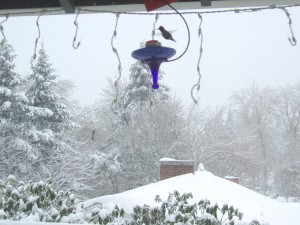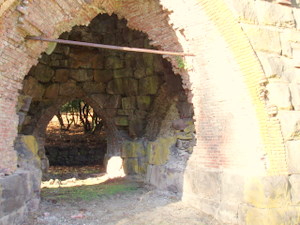Lake Oswego saw two properties enter the market last week. Feet of snow and ice may stop delivery companies and impair mall traffic the week of Christmas, but the real estate market moves forward! (albeit slightly)
One property went “Pending”, and we have no sales for the week.
Here is the latest Lake Oswego real estate market activity report (see below the tables for additional notes):
NEWLY LISTED (DECEMBER 22-28, 2008)
| ADDRESS |
LIST PRICE
|
TOT. BEDS
|
TOT. BATHS
|
TOT. SQ FT
|
PROP TYPE |
LIST DATE
|
| 12826 Boones Ferry RD 299900 2 2.1 1398 CONDO 12/23/2008 |
| 570 7TH ST 739000 4 2.5 2528 DETACHD 12/23/2008 |
PENDING SALES (DECEMBER 22-28, 2008)
| ADDRESS |
LIST PRICE
|
TOT. BEDS
|
TOT. BATHS
|
TOT. SQ FT
|
PROP TYPE |
DOM
|
| 1428 PINE ST 449000 3 3.1 2738 DETACHD 782 |
Criteria: Homes in the 97034 and 97035 zip code, listed, pending or sold between the dates listed above as reported by the Regional Multiple Listing Service (RMLS). DETACHD refers to Single Family Detached Residence, MFG refers to manufactured housing, and ATTACHD refers to single-family residences with some portion of the structure attached to another property, but not constituting CONDO ownership. DOM stands for days on market, or the number of days from when the listing became active and when it received an acceptable offer.
If links to ACTIVE properties do not bring up property information, the listing may no longer be active, but rather expired, cancelled, pending, or sold.

 Wow! A newscaster said yesterday that we are experiencing the biggest snow event since 1964! For those of you who tune in to the Blotter from out of state, I am attaching a few photos so that you can see what we are talking about. Dianne has posted some for your amusement as well. We usually focus on real estate pretty much exclusively in our Blog, but with this kind of excitement, we can’t resist giving you a little local flavor.
Wow! A newscaster said yesterday that we are experiencing the biggest snow event since 1964! For those of you who tune in to the Blotter from out of state, I am attaching a few photos so that you can see what we are talking about. Dianne has posted some for your amusement as well. We usually focus on real estate pretty much exclusively in our Blog, but with this kind of excitement, we can’t resist giving you a little local flavor. Main roads are kept pretty passable with mostly packed snow, and are sanded regularly (Oregon does not use salt), but side streets, especially hilly ones, are let’s say… invigorating! Kids who have been out of school an extra week this Winter Break are sledding everywhere. Lots of folks have bagged their aspirations of mobility as evidenced by the feet of snow burying their cars on the sides of many roads. Others who are able and so inclined have headed for Mt. Hood where skiing is incredible, and road crews are always ahead of the curve. Trees laden with snow and ice have released some of their burden in the form of limbs in yards and on roadsides. But hey… it’s pretty!
Main roads are kept pretty passable with mostly packed snow, and are sanded regularly (Oregon does not use salt), but side streets, especially hilly ones, are let’s say… invigorating! Kids who have been out of school an extra week this Winter Break are sledding everywhere. Lots of folks have bagged their aspirations of mobility as evidenced by the feet of snow burying their cars on the sides of many roads. Others who are able and so inclined have headed for Mt. Hood where skiing is incredible, and road crews are always ahead of the curve. Trees laden with snow and ice have released some of their burden in the form of limbs in yards and on roadsides. But hey… it’s pretty! Christmas has taken on a completely different tone this year. Instead of filling the malls, people gather in kitchens around batches of cookies. Fireplaces are the center of many homes where friends, family and a variety of hot beverages and toddies complete the picture. The uptick in Internet shopping in the area has kept UPS busy all over! This year is definitely one we will never forget.
Christmas has taken on a completely different tone this year. Instead of filling the malls, people gather in kitchens around batches of cookies. Fireplaces are the center of many homes where friends, family and a variety of hot beverages and toddies complete the picture. The uptick in Internet shopping in the area has kept UPS busy all over! This year is definitely one we will never forget.
 What a market. Some of what CNN reports applies here locally and some does not, but no matter how you look at it, this is the time to buy if you’re so inclined. I am told by mortgage and financial planning experts that rates are not likely to go down, but only up (generally speaking) from here on out.
What a market. Some of what CNN reports applies here locally and some does not, but no matter how you look at it, this is the time to buy if you’re so inclined. I am told by mortgage and financial planning experts that rates are not likely to go down, but only up (generally speaking) from here on out.

 The Lake Oswego City Council has awarded the $830,785 contract, to Pioneer Waterproofing, Inc. Requiring specialized skills, Pioneer Waterproofing fits the bill and has met the standard for brick and masonry restoration in conformance with the Secretary of the Interior’s Standards for the Treatment of Historic Properties. Pioneer Waterproofing has also completed impressive restoration projects which include Vista House, Crater Lake Lodge, Timberline Lodge, and the Portland Art Museum.
The Lake Oswego City Council has awarded the $830,785 contract, to Pioneer Waterproofing, Inc. Requiring specialized skills, Pioneer Waterproofing fits the bill and has met the standard for brick and masonry restoration in conformance with the Secretary of the Interior’s Standards for the Treatment of Historic Properties. Pioneer Waterproofing has also completed impressive restoration projects which include Vista House, Crater Lake Lodge, Timberline Lodge, and the Portland Art Museum.